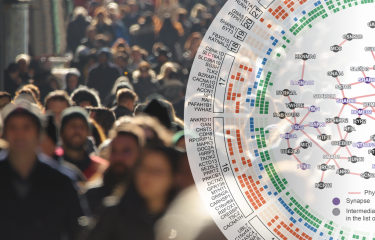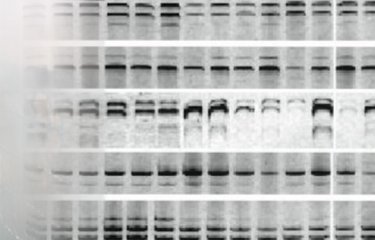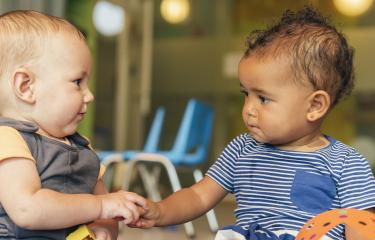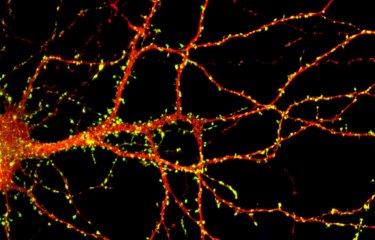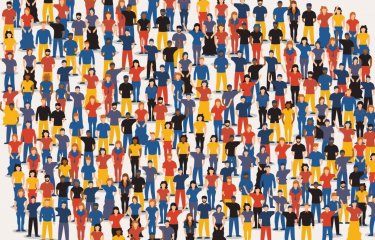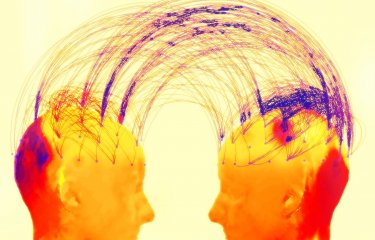Thanks to a large-scale study conducted on nearly 1,000 autistic patients, scientists at the Institut Pasteur, the French National Center for Scientific Research (CNRS), Paris Diderot University and the FondaMental Foundation succeeded in mapping the clinical incidence and impact of certain genetic mutations linked to the cognitive and intellectual abilities of the patients. Mutations affecting the SHANK3 gene were shown to coincide with the most severe cases of autism and are associated with 1 out of 50 children with autism and intellectual deficits. The results of this study were published September 4, 2014 in the journal Plos Genetics.
Autism is a neurodevelopmental disorder that manifests in patients before age 3. It is characterized by social communication difficulties as well as a debilitating degree of restricted and repetitive interests. The disorder affects one person in every hundred with clinical manifestations that vary greatly from one patient to the next.
Since 2003, the team of scientists working under Thomas Bourgeron (Human Genetics and Cognitive Functions Unit - Institut Pasteur/CNRS/Paris Diderot University), in collaboration with the team working under Professor Marion Leboyer (Inserm/Paris-Est University Créteil/Paris Public Hospital Network/FondaMental Foundation), have proven the genetic origin of autism through the discovery of several genes linked to this complex disorder. This concerns, in particular, the SHANK family genes (SHANK1, SHANK2 and SHANK3), which are linked to the development and function of neuronal circuits and more precisely the formation of synapses (the contact points between neurons that allow them to communicate with each other).
And although these genes were shown to be linked to autism, the frequency of mutations and their impact on a clinical level remained largely a mystery. Today, however, as a result of this large-scale study conducted on one thousand autistic patients and their families, scientists are able to prove that the mutations on the SHANK genes are more frequent in patients than previously suggested. They have established a precise description of the clinical characteristics of each sub-group of patients according to the type of mutation (for example, deletions, duplications, translocations) affecting the SHANK1, SHANK2 or SHANK3 genes.
SHANK3 gene plays a major role in autism
The molecular analysis of one of the largest cohorts linked to this syndrome enabled scientists to observe that a mutation on the SHANK3 gene accounts for 2 to 3% of autistic patients with intellectual deficits, meaning that SHANK3 is one of the primary genes responsible for autism. In fact, over a hundred genes have been linked to autism but, in the vast majority of cases, each gene affects only a very small number of patients.
Mutations that determine the severity of the disorder
The scientists established a correlation between the mutations on the SHANK genes, the severity of the disorder and the physical characteristics of patients. In this way they observed that patients with a SHANK3 gene mutation had lower IQs than patients in the SHANK2 sub-group – who in turn had lower IQs than patients in the SHANK1 sub-group. Further clinical signs such as hypotonia, delay in, or lack of, speech, minor malformations, etc. can also be associated with these mutations; development may even regress in some children.
Non-hereditary mutations
After establishing the family trees and genomes of each family, the scientists observed that the most severe mutations to SHANK genes were not hereditary but rather originated de novo in patients whose parents did not carry the mutation.
These detailed studies, which link the gradient of severity to a patient's genome, will pave the way towards pinpointing the role played by other genetic variants that are implicated in the various forms of autism. These results should also help to improve diagnosis and therefore lead to better targeted treatments in future. Moving forward with this research on autism will include studying neurons derived from patient cells, identifying which molecules will restore neuronal function and initiating the first clinical trials based on these findings.
This study received funding from the Fondation Bettencourt-Schueller, the Fondation Orange, the FondaMental Foundation, the Conny Maeva Charitable Foundation, the Fondation Cognacq-Jay and Tarifold.
Source
Meta-Analysis of SHANK Mutations in Autism Spectrum Disorders: A Gradient of Severity in Cognitive Impairments, Plos Genetics, September 4, 2014.
Claire S Leblond(1,2,3), Caroline Nava(4,5,6), Anne Polge(7), Julie Gauthier(8), Guillaume Huguet(1,2,3), Serge Lumbroso(7), Fabienne Giuliano(9), Coline Stordeur(1,2,3), Christel Depienne(4,5,6), Kevin Mouzat(7), Dalila Pinto(10), Jennifer Howe(11), Nathalie Lemière(1,2,3), Christelle C Durand(1,2,3), Jessica Guibert(1,2,3), Elodie Ey(1,2,3), Roberto Toro(1,2,3), Hugo Peyre(12), Alexandre Mathieu(1,2,3), Frédérique Amsellem(1,13,14), Maria Rastam(15), I. Carina Gillberg(16), Gudrun A Rappold(17), Richard Holt(18), Anthony P Monaco(18), Elena Maestrini(19), Pilar Galan(20), Delphine Heron(21,22,23), Aurélia Jacquette(21,22), Alexandra Afenjar(21,22,23), Agnès Rastetter(4,5,6), Alexis Brice(4,5,6), Françoise Devillard(24), Brigitte Assouline(25), Dominique Bonneau(26,27), Beatrice Regnault(28), Diana Zelenika(29), Marc Delepine(29), Mark Lathrop(29), Damien Sanlaville(30), Caroline Schluth-Bolard(30), Patrick Edery(30), Laurence Perrin(31), Anne Claude Tabet(31), Michael J Schmeisser(32), Tobias M Boeckers(32), Mary Coleman(33), Daisuke Sato(11), Peter Szatmari(11), Stephen W Scherer(11), Guy A Rouleau(34), Catalina Betancur(5,35,36), Marion Leboyer(14,37,38,39), Christopher Gillberg(16,40), Richard Delorme(1,2,3,13,14$), Thomas Bourgeron(1,2,3,14$*)
1 Institut Pasteur, Human Genetics and Cognitive Functions Unit, Paris, France
2 CNRS URA 2182 Genes, Synapses and Cognition, Institut Pasteur, Paris, France
3 University Paris Diderot, Sorbonne Paris Cité, Human Genetics and Cognitive Functions, Paris, France
4 INSERM U975 - CRICM, Institut du cerveau et de la moelle épinière (ICM), CNRS 7225 - CRICM, Hôpital Pitié-Salpêtrière, Paris, France
5 Université Pierre et Marie Curie, Paris 6, Paris, France
6 UMR_S 975, Paris, France
7 Laboratoire de Biochimie, CHU Nîmes, Nîmes, France
8 Center of Excellence in Neuroscience of the Université de Montréal (CENUM), Centre de Recherche du Centre Hospitalier de l'Université de Montréal (CRCHUM), and Department of Medicine, University of Montreal, Montreal, Quebec, Canada
9 Department of Medical Genetics, Nice Teaching Hospital, Nice, France
10 Departments of Psychiatry and Genetics and Genomic Sciences, Seaver Autism Center, The Mindich Child Health & Development Institute, Mount Sinai School of Medicine, New York, USA
11 The Centre for Applied Genomics and Program in Genetics and Genome Biology, The Hospital for Sick Children, Toronto, Canada
12 Laboratoire de Sciences Cognitives et Psycholinguistique, École Normale Supérieure, CNRS, EHESS, Paris, France
13 Assistance Publique-Hôpitaux de Paris, Robert Debré Hospital, Department of Child and Adolescent Psychiatry, Paris, France
14 FondaMental Foundation, Créteil, France
15 Department of Clinical Sciences in Lund, Lund University, Lund, Sweden
16 Gillberg Neuropsychiatry Centre, University of Gothenburg, Gothenburg, Sweden
17 Institute of Human Genetics, Heidelberg University, Heidelberg, Germany
18 Wellcome Trust Centre for Human Genetics, University of Oxford, Oxford, UK
19 Department of Biology, University of Bologna, Bologna, Italy
20 Nutritional Epidemiology Research Unit, INSERM U557, INRA U1125, CNAM, University of Paris 13, CRNH IdF, Bobigny, France
21 Assistance Publique-Hôpitaux de Paris, Hôpital Pitié-Salpêtrière, Département de Génétique et de Cytogénétique, Unité fonctionnelle de génétique clinique, Paris, France
22 Centre de Référence "Déficiences intellectuelles de causes rares", Paris, France and Groupe de Recherche Clinique "Déficience intellectuelle et autisme", UPMC, Paris, France
23 Assistance Publique-Hôpitaux de Paris Hôpital Armand Trousseau, Service de Neuropédiatrie, Paris, France.
24 Genetics Department, Hôpital Couple-Enfant, Grenoble, France
25 CADIPA, Centre de Ressources Autisme Rhône-Alpes, Saint Egrève, France
26 INSERM U771 and CNRS UMR 6214, Angers, France
27 Département de Biochimie et Génétique, Centre Hospitalier Universitaire, Angers, France
28 Eukaryote Genotyping Platform, Genopole, Institut Pasteur, Paris, France
29 Centre National de Génotypage, Evry, France
30 Hospices Civils de Lyon, CHU de Lyon, Genetics department, and Centre de Recherche en Neurosciences de Lyon, CNRS UMR 5292, INSERM U1028, Claude Bernard Lyon I University, Bron, France
31 Assistance Publique-Hôpitaux de Paris, Hôpital Robert Debré, Département de Génétique et de Cytogénétique, Paris, France
32 Institute for Anatomy and Cell Biology, Ulm University, Ulm, Germany
33 Foundation for Autism Research, Sarasota, Florida, USA
34 Montreal Neurological Institute, McGill University, Montreal, Canada
35 INSERM U952, Paris, France
36 CNRS UMR 7224, Paris, France
37 INSERM U955, Psychiatrie Génétique, Créteil, France
38 Université Paris Est, Faculté de Médecine, Créteil, France
39 Assistance Publique-Hôpitaux de Paris, Hôpital H. Mondor and A. Chenevier, Département de Psychiatrie, Créteil, France
40 Institute of Child Health, University College London, London, UK
$ Ces auteurs ont contribué équitablement à cette publication.
* Corresponding author



